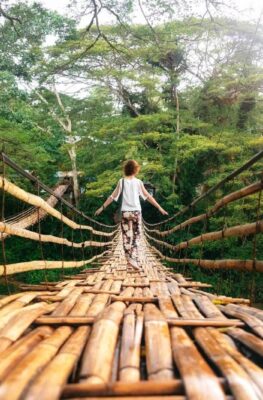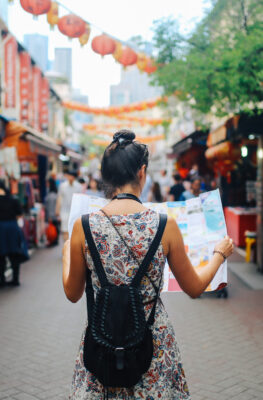Published on December 15, 2014
Just when it was about to take a right turn to enter the road to my hotel, the taxi came to a grinding halt, giving way to a flamboyantly dressed up Dragon Dance Group.
I was taken by surprise as the last thing expected on this inauspicious day in September was an outpour of festivities. After all, I had left the colours of truly Asia behind me to visit the most developed of all ASEAN nations. A country renowned for its shopping malls, entertainment, industrious workforce and high degree of organization. Naturally it would have modern forms of festivities, like its popular Formula 1 motor car racing event; and Songkran for sure, that water splashing orgy, but a traditional festival wasn’t on my mind. Yet, it was there, in front of my eyes in the remnants of Singapore’s centuries old China Town.
Welcome to the Mid-Autumn Festival, the taxi driver elucidated cheerfully. Ay me, how could I have forgotten? I had witnessed this festival in Vietnam for many years from my vintage living quarters in downtown Hanoi, near the Opera. Although in Vietnam merely dedicated to children nowadays, the festival, better known as the Mooncake or Lantern Festival, is undoubtedly one of Singapore’s most important Chinese celebrations for all walks of life in the country.

Mid-Autumn Festival, Singapore 2011; Source: www.hjtan-pixs.blogspot.com
Conventionally spent with family and friends to view the full moon together, while indulging in tasty mooncakes (tartlets with a full-bodied dense content, commonly made from red beans or lotus seed paste), it also drives people out onto the streets, spectacularly ornamented with thousands of miniature lanterns of varying appearances, dimensions and hues, savoring both Singaporeans and tourists alike. Parts of these are stemming from a lantern making and a lantern painting competition. There is also a festive street bazaar & carnival, cultural exhibitions and the obligatory dragon dance performance, in the midst of which I found myself stranded, soaking up part of Chinese culture, though leaving the sampling of Chinese mooncakes delicacies to the driver.
But that was some months ago, in early September. Throughout the year, however, there are several festivals celebrated by main religions and beliefs. This month of December, for instance, you’ll be able to witness a festival one wouldn’t quickly associate with Asia at face value. But, in this city-state, with its blend of different religions, cultures and people from every country, actually it’s not too surprising that Christmas became a National Holiday. Almost one-fifth of all Singaporeans are Christians; yet the celebration is mainly a nonspiritual occurrence, shopping being the main recreational activity. Most malls offer longer opening hours and every store displays a beautifully ornamented Christmas tree.
A non-profit organization, supported by the National Council of Churches Singapore organizes festivities under the banner of “Celebrate Christmas in Singapore”. Performers are volunteers & artists who come from all over the world. Since the first event in 2004, more than 200 groups with performers from more than 100 countries have performed at the various events & venues over the years.
Singapore’s main shopping artery Orchard Road is adorned with lights of all kinds over its 2km length, showering the whole area in a sea of radiance. This ‘light-up’ is now very much a characteristic of Christmas in Singapore, with the Marina Bay Sands area joining in lately on the revelries by showcasing shining, festooned trees along the water side boulevard.

The iconic Raffles Hotel, Singapore, in full Christmas Regalia; Source: www.goseasia.about.com
Another anniversary, Hari Raya Puasa (“Day of Celebration”), is observed by Muslims on a grand scale in the city’s Arab Quarter. It marks the end of the Ramadan and is a public holiday that falls on the first day of the 10th month (Syawal) of the Islamic lunar calendar. The streets of Geylang Serai (the main Malay village) and Kampong Glam (home to the grand Sultan Mosque) come alive with performances and street bazaars. Both districts attract Singaporeans of all races. The festival rewards the self-restraint during Ramadan, and symbolizes purification and renewal and signifies a victory of self-restraint.
The most important festival of the city’s Hindus is known as Deepavali (aka Diwali), the ‘Festival of Lights’ (15th day of Kartika, Hindu calendar; October or November). Deepavali marks the homecoming of the God Lord Ram after vanquishing the demon king Ravana and symbolizes taken people from darkness to light and the victory of good over evil. Thousands flock to the newly-renovated Sri Veeramma Kaliamman Temple in Little India that has been a popular pace of worship in Singapore for decades.
Henceforth, the streets of Little India are transformed into stunning joyful themes using lights and colourful decoration. Serangoon Road (after which a famous TV series was named) is the epicenter of activity, but there’s lots to be seen on neighbouring roads (Hastings, Kerbau and Campbell) as well. The entire zone comes alive in an outburst of stunning street trimmings and dynamic pyrotechnics. Everywhere you’ll find booths offering vibrant festive items, Indian ethnic attire, sophisticated jewellery, clothes, arts and crafts, music, spices, traditional meats, sweets and much more.

Deepavali lights in Little India, Singapore; Source: www.connie.sg
Finally, if you are in full celebratory mood, why not join in the numerous festivities of Chinese New Year, lasting for 15 days beginning on the 1st day of the 1st month of the Chinese lunar calendar.
At the cheerful street fairs you can find over 500 booths, presenting treats such as waxed duck, barbecued sweet meats, Chinese calligraphy prints, Opera masks, and traditional New Year decorations. The showpiece of the festivities is the Chingay Parade, a grand carnival with dazzling floats, spectacles and dances.

Chingay Parade 2012, Singapore; Source: www.wisatasingapura.sg
Vibrant, dynamic Singapore, always on the move, with more on offer than expected. Grab a cab and get bedazzled by its festivals and a lot more!

Map of Singapore with indications of some Festival locations mentioned in the text, a/o Little India, Arab Quarter, Chinatown, Raffles, Orchard Road and Marina Bay Sands; Source: www.asiaforvisitors.com






